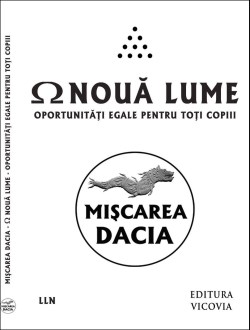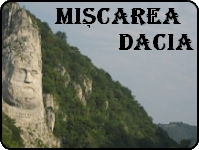 Vă invit să vă alăturaţi grupului Facebook Mişcarea DACIA, ce-şi propune un alt fel de a face politică!
Vă invit să vă alăturaţi grupului Facebook Mişcarea DACIA, ce-şi propune un alt fel de a face politică!Citiţi partea introductivă şi proiectul de Program, iar dacă vă place, veniţi cu noi !
O puteţi face clicând alături imaginea, sau acest link
Posts Tagged ‘revoluţie’
Happy Bastille Day!
ACUM, ori NICIODATĂ!!!
HIPERUMANITATEA, sau EXTINCŢIA!!!
Happy Bastille day, one of the most momentous days in human history. Let it be an inspiration to us as we fight to finish what it started.
A Guide to the French Revolution
For Bastille Day, we have answers to a bunch of questions about the French Revolution.

Henry Singleton, “The Storming of the Bastille.”
What was the French Revolution?
The French Revolution was one of the most dramatic social upheavals in history. In 1856, French sociologist Alexis de Tocqueville reviewed the so-called “grievance books” — lists of demands made by the various social layers of France in anticipation of the Estates-General, the assembly that would undermine Louis XVI’s reign and lead ultimately to revolution. What he discovered startled him.
When I came to gather all the individual wishes, with a sense of terror I realized that their demands were for the wholesale and systematic abolition of all the laws and all the current practices in the country. Straightaway I saw that the issue here was one of the most extensive and dangerous revolutions ever observed in the world.
The revolutionary process started with open rebellion in the summer of 1789 — including the storming of the Bastille on July 14. It would before long topple the absolute monarchy of Louis XVI, divest the nobility of their hereditary power, and completely undermine the political influence of the Catholic Church.
This dramatic revision in French society unleashed a chaotic process of revolutionary advance and reactionary blowback. The forces of property were unwilling to stand idly by as their enormous privileges were threatened; they attempted to undo all the radical changes brought on by the revolution and restore the old social hierarchies even as the revolutionaries worked to cohere an entirely different kind of society based on more egalitarian ideals.
From this unstable crucible ultimately emerged Napoleon, who would construct the Bonapartist state through war and empire, ultimately leading to France’s renewed subjugation by the old powers of Europe and the restoration of the monarchy.
What was France like before the revolution?
The vast majority of people in France lived in destitution, with little chance of escaping their condition. Peasants were entirely at the mercy of the nobility, who had preserved much of the fundamental power relationship of feudalism. As Jean Jaurès described in 1901, the economic subjugation in the countryside was profound:
There was not one action in rural life that did not require the peasants to pay a ransom… Feudal rights thus extended their clutches over every force of nature, everything that grew, moved, breathed […] even over the fire burning in the oven to bake the peasant’s poor bread.
This led to near-universal poverty in the countryside. English agriculturalist Arthur Young remarked at the time:
The poor seem poor indeed; the children terribly ragged, if possible worse clad than if with no clothes at all; as to shoes and stockings they are luxuries… One third of what I have seen of this province seems uncultivated, and nearly all of it in misery. What have kings, and ministers, and parliaments, and states, to answer for their prejudices, seeing millions of hands that would be industrious, idle and starving, through the execrable maxims of despotism, or the equally detestable prejudices of a feudal nobility?
The urban population of artisans and journeymen laborers experienced similar hardship. Economic reorganizations in the kingdom threatened the apprenticeship system, jeopardizing the ability of craftsmen to control their own work. Day laborers — permitted to exist in the cities only when they could produce papers proving their employment — were stalked by royal police.
At the same time, a wave of immigration brought dramatic demographic changes to Paris. Historian Eric Hazan estimates that in 1789 immigrants numbered about two thirds of the city’s population, and they each had to “request a passport in their region of origin to avoid being arrested en route as vagabonds and sent to beggars colonies.”
The clergy and nobility, together comprising about 1.6 percent of the population, were doing just fine — most nobles lived in extreme opulence and inherited their positions hereditarily. The Catholic Church controlled by some estimates 8 percent of total private wealth.
But in the years immediately prior to the revolution, a new class of financiers — generally upwardly mobile craftsmen or landholding peasants — began to grow in the cities, threatening to replace the nobility as the most decadent of social layers.
Meanwhile, the kingdom was in the midst of a catastrophic financial crisis. The king was broke, and the system of accounting that had developed chaotically during the Seven Years War left the his functionaries unable to account for the kingdom’s wealth until it had almost disappeared. Foreign financiers were recalling their debts, the harvest of 1788 was decimated by a drought and a series of hailstorms, and the free trade agreement brokered between France and Great Britain at the end of the Seven Years War flooded the French market with British textiles, ruining French garment production.
Things were bad. Panicked about the financial crisis, Louis XVI squeezed the people even harder, demanding increased taxes from all layers of society.
But there were rumblings of resistance, in the cities as well as the countryside. Elites like Louis-Sébastien Mercier expressed dismay at the insubordination of urban workers:
There has been visible insubordination among the people for several years now, and especially in the trades. Apprentices and lads want to display their independence; they lack respect for the masters, they form corporations [associations]; this contempt for the old rules is contrary to order… The workers transform the print shop into a real smoke den.
And peasants, still expected to sacrifice even their most basic of foodstuffs as tribute to king and church, took matters into their own hands as famine loomed. As one mayor of a rural district remarked, “It is impossible to find within half a league’s radius a man prepared to drive a cartload of wheat. The populace is so enraged they would kill for a bushel.” The starving peasants were unwilling to deliver flour to their feudal masters to satisfy the demands of an enormous war debt; they prefered to eat it instead.
What other solution but revolution?
What happened on July 14, 1789?
The storming of the Bastille on July 14, 1789 represents the popular revolution’s inaugural moment. Encouraged by the rapid pace of reforms — and exasperated with the National Assembly’s unwillingness to take a harder line with the intransigent king — masses of artisans and laborers assaulted the Bastille de Saint-Antoine, seized its gunpowder, and released the handful of prisoners held there.
By claiming the fortress on behalf of the revolution, they sent a powerful message to the forces of old wealth that still dominated the kingdom — the upheaval in France would not be a simple legislative reorganization, but rather a social revolution. From this point forward, the French revolutionary process would, in many ways, take its lead from a volatile popular insurrection that surged again each time its gains were threatened.
Hazan describes it this way:
The storming of the Bastille is the most famous event in the French Revolution, and has moreover become its symbol throughout the world. But this glory rather distorts its historical significance. It was neither a moment of miracle, nor a conclusion, nor a culminating point of the ‘good’ revolution before the start of the ‘bad’, that of 1793 and the Terror; the storming of the Bastille was one shining point on the trajectory of the Paris insurrection, which continued its upward curve…
Foreshadowing the dramatic seizure of Tuileries by thousands of sans-culottes in 1792 — which would establish the insurrectional Commune and finally depose the king — the storming of the Bastille represents neither culmination nor catalyst of the French Revolution. Rather, it was a moment in which masses of oppressed Parisians thrust themselves into the process of reform already underway in France, challenging the king’s absolutism as well as the authority of the overcautious legislative assemblies. In this way, they helped transform what could have been a period of cautious reform into a period of genuine revolution.
Who were the sans-culottes?
The sans-culottes were the insurrectionary “movement of the laboring poor” who, in historian Eric Hobsbawm‘s words, “provided the main striking-force of the revolution.” Named for their lack of the distinguished breeches worn by elites, the sans-culottes inhabited the political terrain of the street and the square as the bourgeois revolutionaries performed their political work in assembly halls and from within legislative bodies.
Most fundamentally, the sans-culottes were concerned with establishing a system of direct, local democracy which could guarantee a consistent price of for vital provisions — the poor craved the same food security as the nobles, and resented the profound difference between the bread consumed by rich elites and the bread available to common laborers.
A popular uprising ejected Louis XVI from his final hiding place in Tuileries on August 10, 1792 — a tremendous victory for the armies of sans-culottes who descended en masse upon the king, accusing him (quite rightly) of treasonous collusion with foreign monarchies to squash the revolution at home. Following this victory, the sans-culottesformed the Insurrectional Commune and proposed a sweeping reform: “equality and bread.” They wrote, “Wealth and poverty must disappear in a world based on equality. In future the rich will not have their bread made from wheaten flour whilst the poor have theirs made from bran.”
Twin aspirations motivated the sans-culottes: freedom from tyranny and access to bread.
The sans-culottes’ demand for fixed prices on foodstuffs offers insight into the development of the French economy in this period — as more and more artisans were stripped of their self-sufficiency and forced to accept wage labor, they discovered themselves unable to afford even simple consumer goods. For the sans-culottes, demanding lower food prices — not higher wages — was the intuitive response to the transition to wage labor.
Often armed only with pikes — useful for parading the severed heads of food-hoarders or monarchists through the street, as was their habit — the sans-culottes did more than just pose a grave threat to the old hierarchies of the monarchy. They also forced formal revolutionary bodies like the Legislative Assembly to adopt more radical positions to meet the expectations of the unsatisfied and insurgent poor.
Though historian Albert Soboul tried to make the case that the sans-culottes were a peculiar kind of proletariat — as did socialist Jean Jaurés — this category makes little sense in the context of eighteenth-century French society. Instead, the sans-culottes were a social coalition comprised of those who were pinched the hardest by the changing French economy, including day laborers constantly on the hunt for underpaid work, artisans (like the garment-makers) whose livelihoods were threatened by the transition to more industrial modes of manufacturing, and apprentices who were no longer permitted to form “corporations” (trade associations).
Consistently denied the democracy and plenty promised by the revolution, the sans-culottes repeatedly took things into their own hands, driving the revolutionary momentum forward each time the bourgeoisie proved hesitant to further challenge the status quo. Whatever their particular class position, their contribution to the revolution was profound. As Hazan writes:
It is true that the notion [of the ‘sans-culotte’] is fairly elastic, sometimes conjuring up by metonymy the world of popular Paris, sometimes the crowds of the great revolutionary journeés, sometimes again the militants who dominated the life of the sections. But the often violent confrontations with the assemblies and established authorities were not the work of a stereotypical ideal: they show the very real presence of this being of flesh and blood, the Parisian sans-culotte.
Sans-culotte is as sans-culotte does. Constant confrontation with the privileged, often violently and in the street, demanding a world in which food is easily available and democracy simple and direct — this orientation, more than anything else, makes a sans-culotte.
Who were the Jacobins?
Following the mass insurrection of the sans-culottes that effectively dissolved the monarchy and brought the armed bourgeoisie to power, European monarchies feared the French example would destabilize their power in their own countries. Austria took the side of the deposed regime, as did Prussia. Revolutionary France responded with declarations of war in 1792.
Meanwhile, the sans-culottes — having recently learned the power of armed mobilization — continued to make demands on the revolutionary government, threatening not only the old figures of the ancien regime but also the ascendant bourgeoisie.
In response to this crisis, the Committee of Public Safety was formed as a bulwark against the aggression of the wealthy, both French and foreign. The Committee was convened under the leadership of the most militant section of the revolutionary bourgeoisie — the Jacobins.
Officially called the Society of the Friends of the Constitution, the Jacobin Club in the period of Maximillien Robespierre embodied the most radical response to the revolutionary crisis; to defeat the forces of reaction, they found themselves compelled to take radical measures — including price controls, food seizures, and the period of tactical violence that would come to be known as the “Reign of Terror.” While in early periods the Jacobin Club had included more moderate actors, the radical wing that cohered around Robespierre — known as the Montagnards — ultimately became the dominant tendency within the Jacobins’ ranks.
Politically, these Jacobins were radically different from the forces that held power in the earlier stages of the revolution — constitutional monarchists like Lafayette (who despised the Jacobins, calling them “a sect that infringes sovereignty and tyrannies citizens”), liberals like the stargazing Parisian mayor Jean-Sylvain Bailly, and more conservative republicans like the militarist Jacques-Pierre Brissot.
Although their leadership was drawn from the ranks of the intellectual bourgeoisie — not the sans-culottes — the Jacobins were committed to separating the right of political participation from property; Robespierre wrote in 1791, “every citizen has the right to cooperate in legislation, and hence to be elector or eligible, without distinction of fortune.”
In fact, the Jacobin Club — along with the networks of fraternal organizations that sprung up to disseminate revolutionary teachings — had been instrumental in producing the very layers of radicalized working people who would later come to be known as the sans-culottes. In the absence of political parties as we understand them today, the sans-culottes received their political education from revolutionary societies like the Jacobins, who produced newspapers and called gatherings where revolutionary propaganda was read aloud.
The Jacobin Club, by virtue of its size and militancy, had even influenced discussions in the National Assembly during the revolution’s early stages. As the Abbé Grégoire recalled:
The Jacobins would take it [a question booed by the conservative majority of the Assembly] up in their circular invitations or their papers; it was discussed by four or five hundred affiliated societies, and three weeks later addresses poured into the Assembly asking for a decree on a matter that had initially been rejected, but which the Assembly then accepted by a large majority, since public opinion had been matured by discussion.
Eric Hazan explains, “The society and its branches operated as a system for spreading revolutionary ideas across the country. Nothing is more absurd than the idea of ‘Jacobinism’ as an authoritarian and meddlesome Paris dictatorship.”
Above all else, the Jacobins were intensely concerned with translating the revolutionary fervor of 1789 into a durable and sustainable revolutionary society. They saw their role as to strengthen and deepen the radical ideals of the Revolution while protecting it from attack. As Robespierre wrote in 1794:
[W]hen, by prodigious efforts of courage and reason, a people breaks the chains of despotism to make them into trophies of liberty; when by the force of its moral temperament it comes, as it were, out of the arms of the death, to recapture all the vigor of youth; when by tums it is sensitive and proud, intrepid and docile, and can be stopped neither by impregnable ramparts nor by the innumerable armies of the tyrants armed against it, but stops of itself upon confronting the law’s image; then if it does not climb rapidly to the summit of its destinies, this can only be the fault of those who govern it.
What should we think about the “Reign of Terror”?
The Reign of Terror was a period of intense violence led by Robespierre’s Jacobins, during which the guillotine became the most potent political tool and repression the most vital political task. Though far fewer than the millions who lost their lives during the Napoleonic Wars, 17,000 people — counter-revolutionaries as well as dissident thinkers within the revolution — were executed by the guillotine. Tens of thousands more were killed without trial or died in jail — historian Timothy Tackett estimates a total death toll closer to 40,000.
The legacy of this period is still much debated. But it is hard to dispute that the terror emerged in response to the urgent need for political and military defense. The old figureheads of the ancien regime were more than mere symbols of opulence or historical tyranny; many were active antagonists of the revolution, working to dismantle its progress and assassinate its soldiers precisely at the time when the revolutionary transformation was most vulnerable.
Robespierre wrote in 1794:
If the spring of popular government in time of peace is virtue, the springs of popular government in revolution are at once virtue and terror: virtue, without which terror is fatal; terror, without which virtue is powerless. Terror is nothing other than justice, prompt, severe, inflexible; it is therefore an emanation of virtue; it is not so much a special principle as it is a consequence of the general principle of democracy applied to our country’s most urgent needs.
It has been said that terror is the principle of despotic government. Does your government therefore resemble despotism? Yes, as the sword that gleams in the hands of the heroes of liberty resembles that with which the henchmen of tyranny are armed. Let the despot govern by terror his brutalized subjects; he is right, as a despot. Subdue by terror the enemies of liberty, and you will be right, as founders of the Republic. The government of the revolution is liberty’s despotism against tyranny. Is force made only to protect crime? And is the thunderbolt not destined to strike the heads of the proud?
. . . Indulgence for the royalists, cry certain men, mercy for the villains! No! mercy for the innocent, mercy for the weak, mercy for the unfortunate, mercy for humanity.
One more thing seems nearly certain: sending political opponents within the ranks of the revolutionaries to the guillotine — the Dantonists, the Hebertists — was a reflection of political weakness that left Robespierre isolated and ultimately defenseless against the plots he so feared.
With the benefit of hindsight, Engels wrote in a letter to Marx in 1870 that:
These perpetual little panics of the French — which all arise from fear of the moment when they will really have to learn the truth — give one a much better idea of the Reign of Terror. We think of this as the reign of people who inspire terror; on the contrary, it is the reign of people who are themselves terrified.
Terror consists mostly of useless cruelties perpetrated by frightened people in order to reassure themselves. I am convinced that the blame for the Reign of Terror in 1793 lies almost exclusively with the over-nervous bourgeois, demeaning himself as a patriot…
Marx himself, though certainly critical of the particulars of “revolutionary terror” as it played out in France, took a less ambiguous stance towards violence in the defense of revolution:
[T]here is only one way in which the murderous death agonies of the old society and the bloody birth throes of the new society can be shortened, simplified and concentrated, and that way is revolutionary terror.
Who ruined the French Revolution?
By the summer of 1794 — five years after the summer of unrest that saw the convening of the Estates-General, the formation of the National Assembly, and the storming of the Bastille — the revolution was fragmented and Robespierre was increasingly isolated, left to occupy a left flank of the revolutionary leadership that was largely devoid of allies or support.
Fearful of conspiracies against his life, Robespierre had argued for the execution of fellow revolutionary leaders like Hebert and Danton while presiding over the Committee for Public Safety. Perhaps predictably, Robespierre did fall victim to a conspiracy from his right, and the dearth of possible allies — the ranks of the moderates and of the left wing having been severely culled by Robespierre’s own expeditions to the guillotine — sealed his doom.
On 9 Thermidor (July 27) of 1794, the National Convention, following the lead of Jean-Lambert Tallien, sentenced Robespierre and three other radical Jacobins to death. After a short-lived insurrection against the National Assembly — led by the Paris Commune, the assembly formed by the sans-culottes and their bourgeois allies after the victory at Tuileries two years earlier — Robespierre and his allies were arrested. The next day, they were executed by guillotine.
A violent purge of the Commune followed. Of its ninety-five leaders present at the time of Robespierre’s capture, eighty-seven died on the guillotine. As Eric Hazan writes, “A new Terror had begun.”
Filippo Buonarroti, a contemporary commentator and friend of Robespierre’s, lamented the monumental defeat, interpreting it as the result of a vulgar alliance between the surviving elements of the old aristocracy and opportunistic revolutionaries on the right wing. To justify their actions, he claims, the leaders of the so-called “Thermidorian reaction” had to distort the legacies of those they opposed, cynically warping revolutionary principles in the service of privilege. He wrote:
The interested professors of democracy, and the ancient partisans of aristocracy, were found to accord once more. Certain rallying cries that recalled the doctrines and institutions of equality, were now regarded as the impure howls of anarchy, brigandism, and terrorism.
Eric Hazan, writing centuries later, is similarly pessimistic:
What was brutally concluded with Thermidor is the incandescent phase of the Revolution, in which men of government, sometimes followed and sometimes driven forward by the most conscious section of the people, sought to change material inequities, social relations and ways of life. They did not succeed, to be sure.
Left unprotected by the popular insurgency of the sans-culottes that, in a previous era, may have come to his aid, Robespierre died without seeing the completion of the revolutionary project he embodied, and the French Revolution died soon after.
The weakened French state, stripped of so much of its democratic potential, could not deliver on the promises of the revolution, and was left in the control of those who would see the revolution’s most radical advances overturned. From this political context soon emerged Napoleon Bonaparte, and the revolution soon mutated into the Bonapartist state, built through war and empire abroad and aristocratic tyranny at home. In perhaps the most perverse example of the inversion of revolutionary principles Buonarotti pointed out, the revolutionary agenda of liberty and equality became a doctrine of global domination through Napoleon’s imperial expeditions.
The revolution was in many respects defeated — though its memories still motivated democratic upsurges like the worker-led Paris Commune decades later.
How did the rest of Europe view the revolution?
The insurrection of the sans-culottes and the liberalization of the French political system had profound effects on the surrounding monarchies. Predictably, the reaction of the monarchs was vastly different from the response of the masses.
The monarchs of Austria and Prussia — including Leopold II, a relative of the French royals — took immediate interest in the popular unrest destabilizing their neighbor kingdom, even colluding with Louis XVI and Marie-Antoinette to orchestrate an inter-kingdom war to weaken the constitutionalist state.
After Louis XVI was prevented from fleeing the nation by angry peasants and evidence of his treason was discovered in Paris, the French people were so outraged they seized the Tuileries and deposed the king, sparking skirmishes with the neighboring monarchs.
But common people in neighboring regions saw inspiration for their own liberation in the French popular struggle. Swiss Guards — hired as mercenaries to defend Louis XVI — defected to the ranks of the sans-culottes en masse during the seizure of Tuileries, and there were similar incidents of side-switching along the border, as soldiers representing the French nation absorbed dissident foreign troops.
Following the French Revolution, popular rebellions also occurred in Italy and Switzerland, citing the French struggle as an ideological and military example.
What was the relationship between the French Revolution and the Haitian one?
Between 1791 and 1804 — during the same period of revolutionary upheaval in the metropole — slaves on the French island of Saint Domingue rose up against the plantation system that maintained their misery, demanding for themselves the rights of citizens. The rebelling slaves dispossessed the planter class of their wealth, executed the remaining planters on the island, abolished slavery, and established Haiti, the first free republic in the Americas.
Among the new nation’s inaugural documents was an appeal to that most fundamental of French revolutionary tracts: the “Declaration of the Rights of Man and Citizen.”
We would do well to remember Marx’s warning: “Ideas can never lead beyond an old world order but only beyond the ideas of the old world order. Ideas cannot carry out anything at all. In order to carry out ideas men are needed who can exert practical force.” So caution is essential to avoid overstating the role of French revolutionary ideology in the formation of the slave rebellion across the Atlantic — the most dramatic challenge ever posed to the hegemony of European slavery.
But it is clear that revolutionary pamphlets from France — of which there were many — did make it into the hands of slaves in Saint Domingue. And certainly the demands of slaves to be incorporated into the revolutionary project of metropolitan France — not to mention the demand for inclusion in the commonwealth of so-called “Enlightenment values” — shaped the revolution’s development in Europe, challenging it to expand its understanding of both man and citizen. C.L.R. James writes:
Excluding the masses of Paris, no portion of the French empire played, in proportion to its size, so grandiose a role in the French Revolution as the half million blacks and Mulattoes in the remote West Indian islands.
What did the Bolsheviks think about the Jacobins?
They were fans.
Even though the Bolsheviks were building a mass party of workers to usher in a socialist society, very different than what the Jacobins sought to accomplish, Lenin saw much to admire in their revolutionary example. He wrote in 1917:
Proletarian historians see Jacobinism as one of the highest peaks in the emancipation struggle of an oppressed class. The Jacobins gave France the best models of a democratic revolution and of resistance to a coalition of monarchs against a republic. The Jacobins were not destined to win complete victory, chiefly because eighteenth-century France was surrounded on the continent by much too backward countries, and because France herself lacked the material basis for socialism, there being no banks, no capitalist syndicates, no machine industry and no railways.
“Jacobinism” in Europe or on the boundary line between Europe and Asia in the twentieth century would be the rule of the revolutionary class, of the proletariat, which, supported by the peasant poor and taking advantage of the existing material basis for advancing to socialism, could not only provide all the great, ineradicable, unforgettable things provided by the Jacobins in the eighteenth century, but bring about a lasting world-wide victory for the working people.
It is natural for the bourgeoisie to hate Jacobinism. It is natural for the petty bourgeoisie to dread it. The class-conscious workers and working people generally put their trust in the transfer of power to the revolutionary, oppressed class for that is the essence of Jacobinism, the only way out of the present crisis, and the only remedy for economic dislocation and the war.
How should we remember the French Revolution?
The French Revolution was an enormous social reorganization affecting some twenty-five million people in France and countless others in regions as geographically distant as Haiti. During the five years of push-pull between the forces of reaction and the will of the revolutionaries, common people experienced great hardship, but also the largely unprecedented opportunity to intervene in matters of national politics and disrupt the exploitative power relationships that defined their lives. As Hobsbawm reminds us:
It was not a comfortable phase to live through, for most men were hungry and many afraid; but it was phenomenon as awful and irreversible as the first nuclear explosion, and all history has been permanently changed by it. And the energy it generated was sufficient to sweep away the armies of the old regimes of Europe like straw.
Eric Hazan concludes his book with another reminder — the French Revolution, in many ways, ended in defeat. The mainstream history is the history of the victors, the forces of reaction who succeeded in cauterizing the revolution on 9 Thermidor. So our task is to excavate the history of France’s great revolution, now buried under over two centuries of permanent counter-revolution. He writes:
The heirs of the Thermidorians, who have governed and taught us continuously ever since, seek to travesty this history. Against them, let us keep memory alive, and never lose the inspiration of a time when one heard tell that ‘the unfortunate are the powers of the Earth,’ that ‘the essence of the Republic or of democracy is equality,’ and that ‘the purpose of society is the common happiness.’
Onwards towards the common happiness. Happy Bastille Day!
MESAJ pentru cei 1%
„Voi CONTROLAŢI lumea noastră. Aţi otrăvit AERUL pe care-l respirăm, aţi contaminat APA pe care o bem, aţi pus PROPRIETATE INTELECTUALĂ pe MÂNCAREA noastră. Noi luptăm în RĂZBOAIELE voastre, murim pentru CAUZELE voastre şi ne sacrificăm LIBERTĂŢILE ca să vă protejăm. Ne-aţi lichidat ECONOMIILE, aţi distrus CLASA MEDIE şi aţi uzat banii noştri din TAXE, ca să vă satisfaceţi nesmărginita AVARIŢIE. Suntem SCLAVII CORPORAŢIILOR voastre, ZOMBIES ai organelor voastre MEDIATICE, servitori ai DECADENŢEI voastre. Ne-aţi furat ALEGERILE, ne-aţi ucis LIDERII şi ne-aţi abolit DREPTURILE FUNDAMENTALE ca fiinţe umane. Ne deţineţi în PROPRIETATE, aţi DELOCALIZAT slujbele noastre şi triturat SINDICATELE. Aţi PROFITAT de DEZASTRE, destabilizat VALUTA şi aţi ridicat COSTUL VIEŢII. Ne-aţi monopolizat LIBERTATEA, distrus EDUCAŢIA şi aproape că ne-aţi stins ASPIRAŢIILE. Suntem LOVIŢI… SÂNGERĂM… dar nu mai e timpul să SÂNGERĂM. Vom pune GIGANŢII în genunchi pentru a asista la a noastră REVOLUŢIE.” – IP
Jos Monarhia!

ILLUMINATI prevăd ca punct de plecare al REVOLUŢIEI… Marea Britanie!?
„Într-o astfel de situaţie de criză , oricine a sfătuit-o pe regină să-și transmită Mesajul de Crăciun anul acesta într-o cameră plină de aur, este fie un deghizat revoluționar, intenționat să aprindă Scânteia, fie servitorul loial al unei monarhii detașate de realitatea trăită de milioane de oameni, ceea ce este atât de evident încât face ca Bourbonii să pară nişte reformatori sociali în comparație. Dacă, așa cum se spune, revoluțiile nu sunt făcute de săraci, ci de cei bogați – cu cei săraci finalizând doar ceea ce încep bogații – Austeritatea în Marea Britanie la sfârșitul anului 2018, care se prelungeşte şi în 2019, REVOLUŢIA nu a fost niciodată mai coaptă. Sunetul pe care îl auziți în depărtare este sunetul unor multiple Furtuni.”
https://medium.com/@JohnWight1/never-mind-brexit-britain-is-fast-becoming-ripe-for-revolution-f43eed97af5e?fbclid=IwAR3TRw1hRtKjaS9wSK6xn2xUl8wSfcnYMtDZlsua0XbcwaqM9FTv1JwQqtI
Saint-Just
„Cei ce fac Revoluţie pentru FIRIMITURI, nu fac altceva decât să-şi sape propria groapă” – Saint-Just
“Those who make revolutions by halves do nothing but dig their own tombs.” — St. Just

NEMESIS
I am Mike Hockney
„NEMESIS era zeița greacă a răzbunării divine. A pedepsit pe cei care au cedat mândriei excesive și narcisismului. În mitul lui Narcissus, ea pedepsește un tânăr egoist, făcându-l să cadă într-o dragoste disperată și necondiționată cu propria sa imagine. Ea este, de asemenea, pedepsitorul tuturor celor îndrăgostiți de natura iluzorie și tranzitorie a lumii materiale. Ea este cunoscută ca distribuitorul destinului, dând tuturor ceea ce merită în măsura potrivită. Orice perturbare a proporției corecte a evocat mânia dreaptă a zeiței.
Ce-ar fi dacă Nemesis ar fi o entitate reală? Ce ar face ea cu porcinele care se hrănesc cu bani pe WALL STREET? Cum ar trata lăcomia excesivă, piețele falsificate și sistemul nostru social bazat pe a face pe câțiva indivizi mai bogați în detrimentul tuturor celorlalți.
Nu avem nevoie de Nemesis astăzi, pentru a restabili echilibrul natural și a ne asigura că toată lumea primește ceea ce Merită???”
I am Mike Hockney:
Nemesis was the Greek goddess of divine retribution. She punished those who succumbed to excessive pride and narcissism. In the myth of Narcissus, she punishes a self-centered young man, making him fall in a desperate and unrequited love with his own image. She is thus also the punisher of all those in love with the illusory and transitory nature of the material world. She is known as the distributor of fate, giving everybody what they deserved in the appropriate measure. Any disturbance of the right proportion evoked the just anger of the goddess.
What if Nemesis were a real entity? What would she do to the money-hoarding pigs on the W. str.? How would she treat excessive greed, rigged markets and our social system based on making a few individuals richer at the expense of everybody else.
Aren’t we in dire need of a Nemesis today, to restore natural balance and ensure that everybody gets what they have worked for?
https://www.amazon.com/God-32-Book/dp/B0771LCTVQ
Tags: Illuminati, Iluminism, meritocraţie, Mike Hockney, Mişcarea DACIA, Nemesis, raţiune, revoluţie, Sistem













